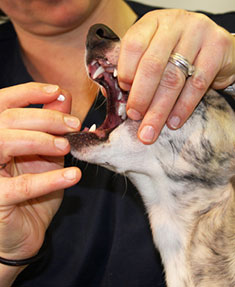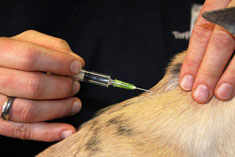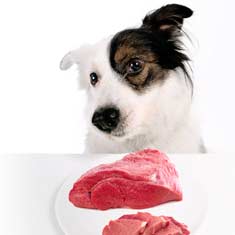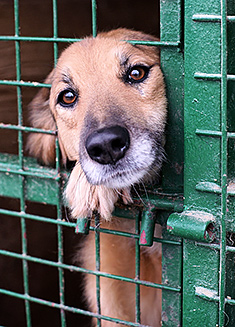Giving Your Dog Medicine
"Just a spoonful of sugar makes the medicine go down...in the most delightful way!" Mary Poppins was right, but giving medication to your dog can be a little trickier than it is for children. For pills, there is the tried and true method of wrapping the medication in a piece of cheese, but some canines are smart enough to eat the cheese and leave the pill. And what about medications that must be given under the skin or in the muscle?

Oral Medications
Probably the easiest medications to give your dog are simple pills like those for heartworm or any number of chronic and acute conditions. Dogs with arthritis pain are sometimes given buffered aspirin while dogs with minor infections may need a course of oral antibiotics. Although you may feel like you are struggling with no end in sight, there are some techniques that can make pill time less stressful for both you and your dog.
For some dogs, mealtime is the best time to give pills. If your dog generally eats quickly, you may be able to simply put the medication in with his or her kibble and the dog won't even notice it. If that doesn't work, you may be able to open the treat jar with the medication hidden in your hand. Have the dog sit or do whatever trick is normally required for a treat, then give the dog the pill. He or she may swallow it before noticing it wasn't a real treat. And then, of course, you can reward the animal for taking the pill by giving a follow-up cookie.
The next easiest way is to wrap the pill in a highly-desired snack such as a meatball, a piece of cheese, or a bite of hot dog. Many dogs Hoover these snacks down so quickly that they never even notice the pill inside, although some dogs are smart enough to work the pill out of the middle and spit it out before swallowing the tasty morsel.
Before you try any of these methods, check with your veterinarian to make sure the pill can be chewed. Some time-release medications must be given whole to allow the drug to be released over the course of time. If the tablet is chewed, all of the medication will be released at one time rather than throughout the day.
If the medication must be given whole, or if your dog is a little smarter than average and you cannot trick him or her with any of the above methods, you may have to resort to basically shoving the medicine down the dog's throat. Or, the medication may have such a strong odor or taste that the dog is simply not interested in it, so you will have to use this method. It's not pleasant for you or for your dog, so try the other ways first, if possible.
To forcibly give your dog a pill takes patience and practice to make it as painless as possible for both of you. Start with your dog sitting at your feet, and spend a few minutes scratching his or her chin to relieve any anxiety. Next, grab the dog's upper jaw in your non-dominant hand and gently pull the mouth open. Make sure your fingers are positioned between the teeth so you will not be bitten if the jaws snap shut unexpectedly.
With your dominant hand, grasp the pill between your thumb and forefinger and use the heel of your hand to push down gently on the dog's lower jaw. As soon as you have the mouth open sufficiently to fit your thumb and finger inside, place the pill as far back on your dog's tongue as possible. Allow the dog's mouth to close, and hold the muzzle shut with one hand while you massage under the chin with the other. Massaging the neck stimulates your dog's muscles to swallow.
Don't let go of the muzzle until you are sure the pill has been swallowed, or you will be picking up the now saliva-soaked and usually melted pill and trying again. You will know your dog has swallowed the pill when he or she begins licking his or her lips. And, of course, it goes without saying that you should reward your dog's stunning performance and cooperation with a treat and some love.

Subcutaneous injections
Some drugs must be given under the skin (subcutaneously) via an injection. One of the most common medications given this way is insulin. Don't worry! You can do this, and the dog probably won't even notice the pinch of the needle.
The easiest way to give a sub-cutaneous shot is to draw up the medication into the syringe just before you put the dog's food dish down. Tap the syringe with your finger to get rid of any bubbles and to make sure the fluid level lines up correctly with the dosage indicators on the syringe.
Put the food dish down, and as the dog is eating, straddle yourself over the dog's back, draw up a fold of skin from the back of the neck, and slip the tip of the needle inside. Pull back slightly on the plunger to make sure you are not in a blood vessel (there should be no blood return), then depress the plunger to dispense the medication. With a little practice, you can have this done before your dog even finishes eating, and he or she will be none the wiser.
If your dog has one of several types of kidney disease, it may be necessary for you to keep the animal hydrated by giving subcutaneous fluids. The basic procedure is the same, although for long-term treatment, your vet may suggest you use an extension set (a plastic tube into which the fluid is pushed) or a drip set (similar to an IV bag you would see in any hospital).
The injections are given on a regularly scheduled basis into the dog's back. Depending on the size of the dog, the procedure may take awhile, and you must attend to your dog the entire time so he or she remains quiet during the procedure. Before giving a second dose, the dog's abdomen is checked to see that no fluids have pooled there. All of one dose of fluids should be absorbed by the dog's system before the next dose is given.
Intra-muscular injections
Some medications must be injected directly into the dog's muscles to allow for slower absorption into the bloodstream. Providing medication in this manner usually takes two people: one to administer the medication and one to control the dog. The assistant should be large enough to keep the dog from moving and should have complete control of the dog's head to prevent bites. The dog should be restrained only enough to prevent injury. The less restraint that has to be used, the less traumatic it will be for both you and the dog.
A common place for intramuscular injections is in the dog's lower back. Once you are completely prepared, have your assistant hold the dog so that you are facing the dog's lower back. To identify the proper area for the shot, you must identify three landmarks: the last (13th ribs), the top of the hip bones, and the vertebrae of the lumbar region. The muscles for which you are aiming lie on either side of the bumpy spinous processes of the lumbar vertebrae, between the bottom ribs and the iliac crests of the hips. You can feel these bony landmarks by simply pressing with your fingers along your dog's lower back, unless your dog is extremely overweight. You will generally inject the dog about two inches from the center of the back, with the dog either standing or lying down on his or her tummy.
Before you begin, wash your hands thoroughly. As with the subcutaneous injections, make sure everything is ready before you approach the dog. Have the medication pre-drawn into the syringe and place any needed supplies within easy reach. Part the dog's fur with your non-dominant hand. If the skin looks dirty, you can wipe it with alcohol first, but be sure to let the alcohol dry for a few seconds before the injection. If the skin is diseased or broken, choose another injection site.
Make sure your assistant is ready and has a firm hold on the dog, then rest the heel of your hand on the dog's back. Rock your hand forward quickly, as if you were throwing a dart, to plunge the full length of the needle into the dog's muscle. Inject the material rather slowly by pushing on the plunger, then withdraw the needle and massage the area to distribute the medication throughout the muscle.
If you are nervous about your first injection, practice with an empty syringe and an orange. The orange peel simulates the amount of resistance you are likely to feel from your dog's skin.
Intravenous injections
Intravenous injections are perhaps the most challenging type of injection to give because a dog's veins are not as readily visible as people's are. These are best done in your veterinarian's office, or at least under your veterinarian's supervision, and will not be covered here.
For any type of injection, make sure you dispose of the used needle and syringe properly to prevent accidental sticks. Place them in an empty coffee can, and then surround them with dog waste from your yard to discourage addicts from taking them out of your trash.
Doggies Den: Latest Articles
 Homemade Thanksgiving Treats for Your Dog
Homemade Thanksgiving Treats for Your Dog
NUTRITION We all want to include our dogs in our holiday celebrations, but hopefully, you're aware that sharing table scraps with your dog isn't always the best idea.
 Keeping Your Dog Safe during the Summer Months
Keeping Your Dog Safe during the Summer Months
HEALTH Summer is coming on fast, so it’s time to plan how you will keep your dog safe and healthy through the lazy, carefree, warm days.
 Vaccination Time Again-Keeping Your Puppy Healthy
Vaccination Time Again-Keeping Your Puppy Healthy
DOG HEALTH So you have your new puppy picked out. There are quite a few shots, treatments and examinations that will keep the newest member of your family healthy.
 Canine Thanksgiving Feast
Canine Thanksgiving Feast
NUTRITION With the wide variety of food at Thanksgiving dinner, chances are you'll want to give your dog something special, too. If you're contemplating what to feed your dog for the holiday, here is a guide to a great Canine Thanksgiving Feast.
 Dog Walking Tips Every Owner Should Know
Dog Walking Tips Every Owner Should Know
DOG FUN Walking your dog is not only crucial to keeping him healthy and happy, it strengthens the bond between your canine friend and his caregiver. There are a lot of obstacles out there. Don’t forget these simple tips to keep your walk fun and safe in the outside world.
 The Benefits of Physiotherapy for your Dog
The Benefits of Physiotherapy for your Dog
HEALTH The same techniques that physiotherapists use to treat a variety of injuries and conditions in humans have been adapted to suit animals with great success. Family pets, show dogs, and working dogs can all benefit greatly from physiotherapy. Dogs whose activities involve a lot of agility are especially susceptible to the types of problems that physiotherapy can address.
 The Decision- Adding a Dog to Your Family
The Decision- Adding a Dog to Your Family
FIRST TIME OWNERSBringing a dog into your family is a decision where many people don’t realize it’s magnitude until after they have the dog. There are a number of things that you need to research before you decide to purchase a dog, and it starts right in your own home.
 Bringing Your Dog Into Your New Baby's Life
Bringing Your Dog Into Your New Baby's Life
HEALTH Many believe that a dog and a new baby cannot happily coexist, so therefore the dog has to go. This is not necessarily the case. A new baby does not mean you have to abandon your dog.

Doggies Den:
Most Popular Articles

Dog Pregnancy Symptoms
HEALTHIf you suspect your dog might be pregnant, check out part one in this series on pregnant dogs, where we cover pregnant dog symptoms.

Dog Birth
HEALTHIn the third article of our dog pregnancy series, we look at the wonderful, but messy, process of bringing newborn puppies into the world.

Indoor Dog Potties
DOG PRODUCTSIt's been a long day at work. You were so busy, you didn't even take time to eat a sandwich, let alone run home to let your dog out. You're on your way home, knowing the poor dog is crossing his or her legs by now, when your car breaks down, delaying you even further. Can't somebody make this easier?

Your Dog’s Digestive System
PHYSIOLOGYEver wonder why your dog eats so fast? Or why he eats gross things? Or why he gets sick to his stomach? Or why his waste stinks so bad? Some of these things are normal, some are not.

Canine Respiratory System
BREATHINGThe basic function of your dog's respiratory system is to bring oxygen in to and remove carbon dioxide from the body. Knowing the symptoms of respiratory diseases can help you help your stay healthy.

Shelter Dog Adoption Tips for Success
ADOPTION Are you intimidated by the prospect of "rescuing" a dog from a shelter? One reason that you may be wary of adopting a dog from a shelter is not knowing how to choose. Adopting a dog from a shelter can be a rewarding process, if you're prepared to do a reasonable amount of research.

Canine Urinary Tract Infections
SYMPTOMS AND TREATMENTDoes your dog seem to be having trouble relieving his or her bladder? Learn how to recognize the signs of urinary tract infections and how to treat them before they spread.

What to do for Dog Diarrhea
SYMPTOMS AND REMEDIESIf you have dogs in your house for any length of time, you have likely experienced at least one bout of dog diarrhea. Beyond the pain in the tuckus involved in cleaning up the mess, you should know what causes diarrhea, and when it's important to see the vet.

What to do for a Dog Bite
DOG BEHAVIOR Getting bitten by a dog can be scary, and you may be tempted to run around in circles for a while, trying to figure out what to do. Here's our guide to help you manage the situation.

Top Ten Tips for Living with a Senior Dog
DOG HEALTH Bringing home a new puppy is so exciting, but it doesn’t take all that long for your exuberant puppy to grow into a senior dog who may have special needs. Here are the doggies.com top ten tips for taking care of your companion who has been with you through so much.
